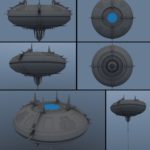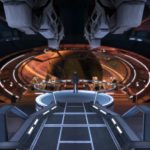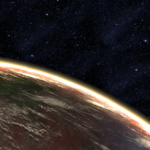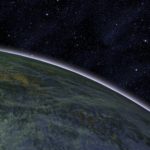System Specs:
- Stellar Mass: 1.7 Sol Masses
- Stellar Class: F0
- Luminosity: 6 Sol
- Planets: 5
- Moons: 0
- Asteroid Belts: 2
- Asteroids: 1
- Objects: 1

This system may be named for the phoenix, a mythical bird from Arabia that burns itself in a fire and is reincarnated from the ashes every 500 years. The stellar mass is derived from Tuntau’s Keplerian ratio, based on its orbital distance of “nearly 20 AU”. That implies the 19-20 AU range and a mass of 1.7-1.8. A value of 1.7 was chosen because it better aligns with the “main sequence” chart.
In Mass Effect, Intai’sei was visually added as the fifth and outermost planet of Phoenix but its in-game numbers actually placed it third, between Sysalto and Tuntau. The error is addressed in Mass Effect 3 and the updated system map now places the third to fifth planets in the correct order.
–
Planets Directory:
- Patashi
- Carbonaceous Asteroid
- Sylsalto
- Pinnacle Station
- Intai’sei
- Tuntau
- Vebinok
–
Patashi:

- Orbital Distance: 0.5 AU
- Orbital Period: 0.3 Earth-years
- Keplerian Ratio: 1.389
- Radius: 7,082 km
- Day Length: 0.3 Earth-hours
- Atmospheric Pressure: 0.00 atm
- Surface Temp: 546 °C
- Surface Gravity: 0.75 g
- Mass: 0.918 Earth-masses
Patashi is a sun-blasted terrestrial world whose atmosphere was blasted away millennia ago by the star Phoenix. The surface is scorching hot, and mainly composed of iron with deposits of tin.
Due to its relatively low density, Patashi is tidally locked to Phoenix. Seas of molten light metals cover much of the sunward side.
–
Carbonaceous Asteroid:

- Orbital Distance: _ 76.4 AU
- Orbital Period: _ 158.0 Earth-years
- Keplerian Ratio: _ 17.863
- Radius: _ 6,959 km
- Day Length: _ 158.0 Earth-hours
- Atmospheric Pressure: _ 0.44 atm
- Surface Temp: _ 1,157 °C
- Surface Gravity: _ 0.66 g
- Mass: _ 0.78 Earth-masses
This asteroid is emitting a weak, intermittent signal at a frequency of 1540 MHz. Radius: 71 km. “During a scan of the Phoenix system asteroid field, you detected an odd energy reading that Tali determined was quarian in nature. She led a recon team into the asteroid field, where she discovered an abandoned freighter. The team could not determine why the ship was there, but they did find a Prothean data disc on board.”
The list of all known such asteroids in the Mass Effect systems can be found here.
–
Sylsalto:

- Orbital Distance: 13 AU
- Orbital Period: 36.0 Earth-years
- Keplerian Ratio: 1.695
- Radius: 56,621 km
- Day Length: 13.6 Earth-hours
- Atmospheric Pressure: _ atm
- Surface Temp: _ °C
- Surface Gravity: _ g
- Mass: _ Earth-masses
Sylsalto is a standard hydrogen-helium gas giant. It has no remarkable features.
Properties
Sylsalto is too large and close to its sun to be a “standard hydrogen-helium gas giant” (William Hubbard, The New Solar System 4th ed, 1999; p. 194). It is more likely an “ice giant” like Neptune or Gliese 436 b.
–
Pinnacle Station:

Test the limits of your combat prowess aboard a remote, top-secret Alliance space station. Do you have what it takes to hold the top spot among the best of the best? This module includes a new land-able space station, 13 exciting combat scenarios, and approximately 2-3 hours of game play.
Compete in a series of high-stakes battle simulations to earn amazing weapons and armor that can be used in the main game. Unlock new achievements, and even win ownership of a dedicated base of operations for Commander Shepard. Challenge modes include Survival, Time Attack, Hunt and Capture and even a scenario modeled after the First Contact War.
Further details here.
–
Intai’sei:

- Orbital Distance: 15.68 AU
- Orbital Period: 47.8 Earth-years
- Keplerian Ratio: 1.687
- Radius: 5,897 km
- Day Length: 27.6 Earth-hours
- Atmospheric Pressure: 0.95 atm
- Surface Temp: 46 °C
- Surface Gravity: 0.8 g
- Mass: 0.679 Earth-masses
- Colony: Human (capital: Thoreau Mesa, founded: 2166 CE, population: 150,000)
An atmosphere similar to Earth‘s made Intai’sei an early candidate for human colonization. However, prohibitively high temperatures and an arid climate have proven a hindrance to terraforming and agriculture. A few human cities were founded, but the majority of the human population on Intai’sei remains scattered across the vast deserts, operating wind farms and geological research stations.
–
Tuntau:

- Orbital Distance: 19.01 AU
- Orbital Period: 63.8 Earth-years
- Keplerian Ratio: 1.688
- Radius: 11,867 km
- Day Length: 69.7 Earth-hours
- Atmospheric Pressure: 3.12 atm
- Surface Temp: 21 °C
- Surface Gravity: 1.1 g
- Mass: 3.78 Earth-masses
Tuntau is an enormous, low-density terrestrial planet, with a thick atmosphere of methane and helium. Despite being nearly 20 AU from Phoenix, the star’s great heat and the insulating thickness of the atmosphere make the surface surprisingly temperate.
The crust is mainly composed of sodium and silicon dioxide with deposits of various light metals. While Tuntau is not habitable, the relative pleasantness of the surface conditions make it a popular location for small ships traveling through the Argos Rho cluster to land for drive discharge.
–
Vebinok:

- Orbital Distance: 24.7 AU
- Orbital Period: 94.5 Earth-years
- Keplerian Ratio: 1.687
- Radius: 3,379 km
- Day Length: 68.3 Earth-hours
- Atmospheric Pressure: 0.27 atm
- Surface Temp: -154 °C
- Surface Gravity: 0.28 g
- Mass: 0.078 Earth-masses
Vebinok is a small terrestrial world with a thin atmosphere of krypton and xenon. Its frozen surface is mainly composed of carbonaceous material, water ice, and low-density silicates. Rare but concentrated lodes of light metals have been deposited by asteroid impacts.
One hemisphere of Vebinok is covered by surface deposits of oxidized copper. Approximately 270 years ago a turian bulk gas transport was attacked by pirates in the Phoenix system. Damaged, it made a rough landing on Vebinok. The heat of the landing melted significant quantities of surface ice, and ruptured shipping containers spilled LOX across the surface. Before this evaporated and escaped Vebinok’s weak gravity, it reacted to cause the widespread rust.
Properties
On the assumption that a thin noble-gas atmosphere this far from the sun is a negligible greenhouse and undergoes negligible chemistry, the planet’s albedo comes out to −2.5. The atmosphere probably has more carbon dioxide, methane, and ozone than the description admits, and with more internal heat – perhaps a result of the accident.
–
video














